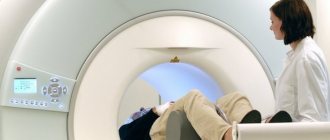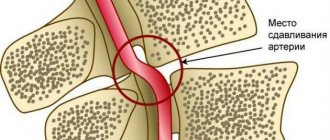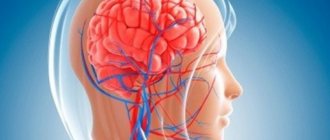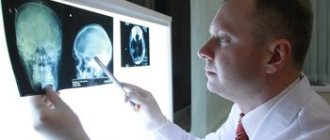Cervical osteochondrosis is a common pathology that manifests itself not only with back pain, limited mobility, but also with other less specific symptoms. These include headaches, increased fatigue, irritability, visual and hearing disorders, etc. This happens because with osteochondrosis, there is a risk of compression of the blood vessels in the cervical region, which transport oxygen and nutrients to the brain.
To get rid of the symptoms of the pathology, patients are prescribed drugs that improve cerebral circulation. In addition to medications, other effective methods are used to treat circulatory problems associated with cervical osteochondrosis. It is important to start treatment as early as possible to avoid dangerous complications that can threaten the patient’s life.
Causes of cerebrovascular accident in cervical osteochondrosis
To understand why blood circulation to the brain is impaired during osteochondrosis, you need to study the anatomy of the cervical spine. The transverse processes of the cervical segment have openings that form a canal, and veins, nerves and vertebral arteries pass through it. The latter arise from the subclavian arteries, pass through the transverse foramen of C6 (sixth cervical vertebra) and rise higher. At the level of the hindbrain, the left vertebral arteries on the left and right join, forming an artery from which the posterior cerebral, internal auditory, and cerebellar arteries (anterior and posterior) depart.
Based on what is described above, arteries pass through the cervical spine, which are necessary for normal blood supply to the brain. In addition, veins and sympathetic nerves are located in the spinal canal.
The transverse foramina are considered narrow, but there is enough space for the neurovascular bundle. Blood vessels and nerves are not pinched even when moving the head (turning, bending).
The cervical vertebrae are connected by elastic intervertebral discs. These are a kind of cartilage pads that soften shocks during running and jumping. These structures also protect nerves and blood vessels from damage.
With cervical osteochondrosis, the discs lose a lot of fluid and become fragile. Increased load provokes flattening of the cartilage pads and the appearance of cracks on their outer shell. As a result, protrusions (protrusions, disc herniations), osteophytes (bone growths) appear, which injure nerves and blood vessels.
Reference. According to medical statistics, about 30% of cases of circulatory failure in the vessels of the brain are associated with damage to the vertebral artery. In most cases, the disorder occurs against the background of cervical osteochondrosis and atheromatosis (overgrowth of connective tissue on the vessel wall).
Cerebral circulation in cervical osteochondrosis occurs for the following reasons:
- The nerve that supplies the vertebral artery is compressed. It provokes a spasm of the artery, then the blood flow to the brain is disrupted.
- Long-term compression of the vertebral artery. Due to constant compression, the lumen of the vessel narrows or is completely blocked (occlusion). The risk of vertebral artery syndrome then increases.
- Rough compression of the vertebral artery, which prevents the outflow of blood. This can happen when turning the head, then the person experiences a severe headache and may lose consciousness.
Compression and stretching of the vertebral arteries can occur even in healthy people. With cervical osteochondrosis, an important vessel is damaged regularly, and then dangerous complications arise.
Symptoms
With prolonged injury to the vertebral artery, the blood supply to the brain is disrupted. Due to hypoxia (lack of oxygen), the risk of ischemia (local decrease in blood supply), dyscirculatory encephalopathy (vascular damage to the brain), and stroke increases.
Dizziness is one of the symptoms of cerebrovascular accident with cervical osteochondrosis
Cerebrovascular accident with cervical osteochondrosis has the following symptoms:
- Visual disturbances, oculomotor disorders. In patients, visual acuity decreases, “fog” appears before the eyes, and diplopia (double vision) occurs. These signs appear in the initial stages of pathology.
- Violation of the vestibular apparatus. Then coordination of movements is impaired, the patient staggers when walking, and the tone of the muscles of the upper extremities decreases. Other symptoms of impaired cerebral circulation include vertigo (dizziness), hearing disorders (noise, ringing, weakening), disturbances in the perception of objects, etc.
- Changing sleep and wakefulness patterns. Due to impaired blood circulation in the brain, the patient feels weakness, increased fatigue, becomes sleepy during the day, and cannot sleep for a long time at night.
- A vegetative-vascular syndrome occurs. Weakness suddenly appears, the heartbeat changes (increases or slows down), surges in blood pressure, and increased intraocular pressure are observed.
- Paroxysmal disorders. People with cervical osteochondrosis may faint after suddenly turning or throwing their head back. This occurs due to severe compression of the vertebral artery and a sudden slowdown in blood flow.
- Mental disorders. The patient becomes suspicious, overly irritable, and takes offense for no apparent reason. His memory and attention are deteriorating.
In addition to the symptoms described above, cervical osteochondrosis is accompanied by severe cephalgia (headache). As a rule, painful sensations begin in the back of the head, but they can spread to the arms. In some patients, throbbing pain appears in the temples, which may be accompanied by the eruption of vomit. The pain reaction intensifies when turning or tilting the head.
With prolonged compression of the vertebral artery, the symptoms intensify and the pathology progresses. In the absence of competent therapy, the risk of disability increases. To avoid dangerous complications, long-term complex treatment is necessary.
Complications
Due to prolonged compression of the vessels of the spinal cord as a result of osteochondrosis, circulatory disorders in the brain naturally develop, which leads to unpleasant consequences:
- Visual disturbances (blurred vision, double vision).
- Problems in organizing movements (unsteadiness when walking).
- Lack of mood, insomnia, fatigue.
- Changes in the vascular system.
- Frequent loss of consciousness.
- Neuropsychiatric disorders (memory loss, seizures, aggression).
- Development of epilepsy.
- Inability to perform usual activities.
- Dementia.
- Increased pain syndrome, for the relief of which it is necessary to start using psychotropic drugs, which have a large number of side effects, especially in relation to the psyche.
After the manifestation of the above symptoms, with inadequate treatment, a stroke may develop. In addition to all sorts of complications of cervical osteochondrosis, there is a possibility of complete loss of ability to work if the treatment was inadequate and untimely. To do this, you need to have an idea of all the effective means that normalize impaired blood circulation. But it is important to remember that self-medication is the wrong path to recovery. It is only within the competence of the attending physician to give recommendations on dosages, regimens and methods of administration of drugs.
Establishing a diagnosis
When the first suspicious symptoms appear, for example, frequent headaches, vertigo, hearing and vision disorders, you should contact a neurologist, reflexologist or vertebrologist.
Currently, the following instrumental methods are used to identify cerebral circulation disorders against the background of cervical osteochondrosis:
- Doppler ultrasound (Doppler ultrasound) of the neck vessels is used to assess the degree of vasoconstriction, as well as measure the speed of blood flow.
- Transcranial Doppler ultrasound is an ultrasound examination of the blood supply to the brain, which allows one to assess blood flow through intracranial vessels. This technique allows you to identify a violation of venous outflow, as well as arterial outflow, to identify spasm or local dilatation of blood vessels (aneurysm).
- X-rays of the spine are used to identify bone growths, as well as areas where the height of the vertebrae is reduced.
- Using magnetic resonance imaging, the doctor can assess the condition of the cartilage linings of the vertebrae, detect protrusions, hernias, and determine their size. In addition, this study is informative regarding blood vessels.
After confirming the diagnosis, the doctor draws up a treatment plan.
About precaution
Do not overuse vasodilators.
Note! You cannot take all drugs of this effect at once. Making a treatment plan on your own can be very risky and dangerous. It is the treating specialist, and not someone else, who must analyze the symptoms, make a diagnosis, and then prescribe the necessary medications.
Every doctor has his own opinion about vasodilator drugs. This may be due to the fact that any small error can cause harm to a person, so it is important to know that such medications:
- provoke the removal of calcium from the body, which can have a negative effect on the restoration of bones and intervertebral discs;
- act not only on affected vessels, but also on healthy ones, and this leads to the opposite effect;
- often lead to a “stealing effect”, i.e. they dilate and improve the condition of healthy blood vessels, and not those for which the therapy was carried out.
Vasodilators have some contraindications and side effects
It is clear that vasodilation as the main treatment for ischemia and atherosclerosis cannot be considered a good option.
Like any medicine, drugs for vasodilation have certain contraindications. Some of them are like this.
- Pregnancy and breastfeeding.
- Epilepsy.
- Cardiac disorders.
- Hypertension, that is, constant high blood pressure.
- Kidney failure.
You should also stop taking medications if you have allergies or individual intolerances.
Features of treatment
Insufficient blood supply to the brain due to osteochondrosis of the cervical segment must be treated comprehensively. The basis of therapy is medications; in addition, other conservative methods are used (physical therapy, physiotherapy, etc.). And in advanced cases, surgery may be necessary.
Doctors have identified the main goals of therapy:
Osteochondrosis and panic attacks
- Restoring the functionality of the brain, improving its blood supply, due to which the organ is saturated with a large amount of oxygen and nutrients.
- Relief of the inflammatory reaction, activation of regeneration processes of damaged tissues.
- Some medications help normalize the composition of the blood, making it more fluid, which improves its quality and speed of movement.
- Expand the lumen of blood vessels, make the damaged areas thicker.
- Stabilize blood pressure.
- Restore the normal structure of the spine, saturate the cartilage tissue with useful substances, and strengthen it.
It is important to understand that complex therapy will help eliminate circulatory problems in the brain, but it will not be possible to completely cure osteochondrosis. But with proper treatment, it is possible to slow down the development of pathology for a long time.
Carefully. You can take any medications for cerebral circulatory disorders due to cervical osteochondrosis only for medical reasons. Otherwise, the symptoms of the disease may worsen or be supplemented with new ones, for example, drug-dependent headaches. When drugs are abused, blood circulation in the brain deteriorates.
Groups of drugs to improve cerebral blood flow
The following groups of medications will help improve cerebral circulation in cervical osteochondrosis:
- Vasodilators accelerate blood flow and transport of nutrients to the brain by increasing the lumen of blood vessels. Tanakan, Vazobral, Cavinton are used for this purpose.
- Medicines that prevent blood clots, for example, Dipyridamole, as well as aspirin-based medications. They improve the permeability of blood vessels and prevent red blood cells and platelets from sticking to their walls. As a result, the blood thins out and flows faster to the brain.
- Diuretics: Mannitol or Furosemide. These medications prevent stagnation and swelling. The first drug is used for excess fluid accumulation in brain cells, the second is suitable for eliminating swelling of any localization.
- Osmodiuretics are the only drugs that do not block urine formation. These include Britomar, Hypothiazide, Veroshpiron. Used to stimulate diuresis in cervical osteochondrosis.
- Antioxidants, for example, vitamin E, Mexidol, Neurox. These tablets improve the condition of nerve endings and reduce harmful oxidative processes in the body's cells.
- Antipsychotics: Glycine, Novo-Passit. These medications slow down the transmission of nerve impulses, relieving pain for a long time. They help cope with stress, prolonged pain, and improve the condition of the spinal nerves.
Tanakan dilates blood vessels and normalizes cerebral circulation
However, it should be remembered that all medications have contraindications, so taking them without the knowledge of a doctor is prohibited.
Drugs to improve cerebral circulation
Doctors have identified drugs that improve blood circulation in intracranial vessels for osteochondrosis of the neck:
- Eufillin is a bronchodilator that eliminates spasm and normalizes blood flow. It is often used during electrophoresis, a physiotherapeutic procedure during which drugs penetrate the body through the skin under the influence of current.
- Trental, based on theophylline and nicotinic acid, saturates the blood with oxygen and improves its quality. When used, microcirculation accelerates, blood vessels dilate, and blood circulation normalizes. The medication can quickly lower blood pressure.
- Berlition contains thioctic acid, which helps expand the lumen of blood vessels. It improves metabolic processes and eliminates vascular spasm.
- Actovegin is based on cattle blood. It helps normalize the condition of intracranial vessels, enriches neurons with oxygen and glucose.
- Pentoxifylline and its substitutes relax the walls of spasmodic blood vessels and thin the blood. As a result, microcirculation improves.
- Nicotinic acid helps dilate small blood vessels, reduces the concentration of bad cholesterol, and restores blood supply to the brain.
- Cinnarizine dilates blood vessels, makes blood less viscous, normalizes microcirculation, and helps get rid of dizziness.
Reference. In case of cerebrovascular accident associated with osteochondrosis, NSAIDs (non-steroidal anti-inflammatory drugs) are used. These medications help relieve pain that occurs in the later stages of the pathology. For this purpose, Ibuprofen, Diclofenac, Indomethacin, etc. are used. However, taking them for a long time without the knowledge of a doctor is prohibited, as they have many contraindications.
As a rule, several drugs are used during therapy according to a specific regimen.
Other groups of medications
If cervical osteochondrosis occurs over a long period of time, then during complex therapy the following groups of drugs are used:
- Antidepressants, for example, Afobazol, Fenozepam. They do not affect the blood circulation of the brain, but they stabilize the psycho-emotional state of the patient.
- Medicines for hypertension: Cardura, Reseprin. These medications are used for prolonged compression of the artery, poor circulation and high blood pressure. They help prevent brain swelling.
- Drugs from the group of low molecular weight dextrans: Reopoliglucin, Reogluman. They thin the blood.
- Calcium antagonists: Phezam, Cinnarizine, Stugeron. They relax the walls of spasmodic vessels, normalize the functionality of neurons, and prevent ischemic reactions.
- Venotonic drugs: Phlebodia, Detralex. Restores blood flow from the brain.
- Nootropic drugs: Piracetam, Ceraxon. They are used when speech, memory, and thinking disorders occur.
- Vitamins: Cytoflavin, Milgamma. They improve the condition of nerve cells, prevent oxygen starvation, and normalize the condition of the body.
- Chondroprotectors: Chondroitin, Dona, Teraflex. Restore cartilage tissue.
- Histaminergic drugs: Betaserc, Vestibo, Betahistine. Eliminate vertigo, improve the functionality of the vestibular apparatus.
Phlebodia normalizes blood flow from the brain
Depending on the symptoms, this list may be supplemented with other medications. But in any case, the decision on the choice of appropriate drugs is made by the attending physician.
Additional Treatments
Combined treatment is complemented by physical therapy, which affects the cause of the disease. With the help of exercise therapy, you can improve blood circulation, metabolic processes, and improve trophism of the spine. With regular exercise, the muscles around the damaged vertebrae are strengthened, which allows them to be slightly relieved. However, to get good results, classes must be carried out regularly.
In case of cerebral circulation disorders associated with cervical osteochondrosis, special gymnastics is indicated
The patient must follow these training rules:
- Start with simple movements at a slow pace and minimal amplitude, gradually increasing the pace.
- Before exercising, massage your neck or take a warm shower to warm up your muscles.
- During training, be attentive to your feelings. At first there may be some discomfort, but after 3-4 days the body will adapt and your health will improve. If this does not happen or acute pain occurs, then visit a doctor.
The complex for each patient is compiled by a doctor, taking into account symptoms, severity of pathology, age and general health.
Reference. It is recommended to supplement exercise therapy in case of cerebral circulation disorders with walking or cycling, swimming, yoga, breathing exercises, and cardio exercises (elliptical, exercise bike).
An auxiliary treatment method is physiotherapy. To improve cerebral circulation, electrophoresis, magnetic therapy, medicinal baths, and acupuncture are prescribed.
In order for the spine and blood vessels to function normally, the patient must eat properly. The diet needs to be supplemented with foods rich in fiber, fatty acids, group B elements, tocopherol, and ascorbic acid. To do this, you need to eat more vegetables, fruits, berries, and herbs. In addition, it is useful for patients to eat fatty sea fish, lean meat, nuts, vegetable oils, etc. It is recommended to drink at least 2 liters of filtered water per day.
With a poor diet, the lack of nutrients can be compensated with the help of vitamin and mineral complexes. Your doctor will help you choose the right drug.
Surgery for poor circulation in the brain due to cervical osteochondrosis is performed only in extreme cases. The need for surgical intervention may arise if there is a large bone growth that compresses the vessel. During the procedure, the osteophyte is removed; if this cannot be done for some reason, then a stent is inserted into the blood vessel.
Contraindications
All of the above drugs have contraindications. Let’s combine the main ones into 3 common, most common ones:
- disorders of the kidneys and liver;
- pregnant and lactating women.
The drugs have contraindications, so it is important to read the instructions before use.
The main contraindication for any of these medications is self-prescription, dosage adjustment without the knowledge of the doctor, as well as unauthorized cancellation when prescribing courses of therapy.
Preventive measures
To prevent cerebrovascular accidents, a person must follow recommendations that will help him avoid diseases of the cervical spine and surrounding vessels:
- Eat right, watch your weight.
- Maintain a moderately active lifestyle, walk more often.
- When working sedentarily, get up every 2 hours and stretch your neck.
- Give up bad habits.
- Sign up for preventive massage courses.
- Get regular medical examinations to spot dangerous problems in time.
By adhering to these recommendations, a person will be able to maintain the health of the spine (including the cervical spine) for a long time.
The most important
Poor blood circulation in the brain with cervical osteochondrosis is a serious pathology that threatens with dangerous complications (stroke, ischemia, disability). To avoid dangerous consequences, you need to visit a neurologist when the first symptoms of pathology appear (headache, loss of coordination, tinnitus). The specialist will conduct a comprehensive diagnosis to distinguish between impaired cerebral blood flow associated with cervical osteochondrosis and other pathologies. With timely complex therapy, the patient will be able to get rid of unpleasant symptoms, slow down the development of pathology and prevent life-threatening complications.








